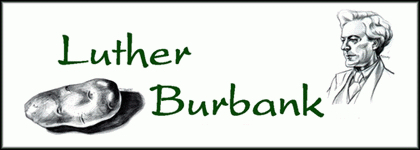Luther Burbank
Luther Burbank was born on March 7, 1849 in Lancaster, Massachusetts. He had only an elementary education but was always an avid reader. At the age of 19, he was profoundly impressed by Charles Darwin's treatise "The Variation of Animals and Plants under Domestication," which opened up a new world to him. At 21, Burbank purchased a 17-acre plot of land. He went on to become one of history's most inventive and productive breeders of plants.
Conducting as many as 3,000 experiments at once, Burbank painstakingly crossbred foreign and native species of plants, cultivated the resultant seedlings, and used grafting to arrive at new and better breeds. Of the tens of thousands of varieties he attempted, hundreds were successful, including the famous "Shasta" daisy. One hundred years after their invention, Burbank's July Elberta peach, Santa Rosa plum, and Flaming Gold nectarine (to name a few) were still on the market.

But his greatest success was the Russet Burbank potato (1871), better known as the "Idaho" potato. This was soon exported to help Ireland recover from the devastating potato blight of 1840 to 1860. And even today, despite all the horticulturists who have followed in his footsteps, Burbank's large, hardy, fine-grained potato is unsurpassed, a staple of American agriculture.
Like George Washington Carver, Burbank realized that human ingenuity could improve nature's productivity. His tremendous success, and also his own book, "How Plants Are Treated to Work for Man" (1921), largely inspired the Plant Patent Act (1930), which made new varieties of plants patentable for the first time. As Thomas Edison said in support of the legislation, "This will, I feel sure, give us many Burbanks."Unfortunately, Burbank died April 11, 1926. However, he received 16 plant patents posthumously. More importantly, he set the precedent for innovation in plant breeding that continues today with the help of bio-engineering.


